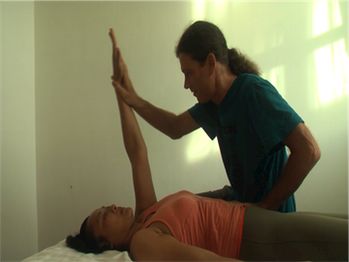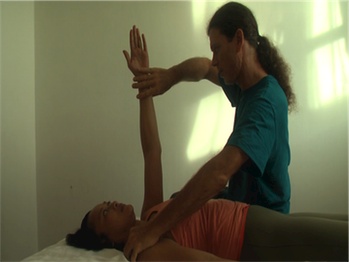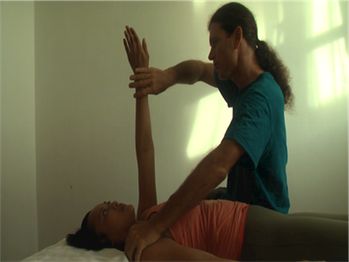The rotator cuff muscles are a group of four muscles that literally hold the shoulder to the rest of your skeleton. They do have help from other muscles, but they are the main ones.
If you experience rotator cuff pain or weakness you might look for rotator cuff exercises, many people do. However, exercises don’t help much as most people have an inherent weakness in the muscles of the rotator cuff. The cause of this weakness will take time to explain, and will be covered in another post.
For now, let’s find out if you have a weakness in this area or not with this simple rotator cuff muscles test. For this test you’ll need a friend to challenge your shoulder muscles for you.
A caution before you start. If there is rotator cuff pain, or the shoulder hurts when you do this test, that is considered a weakness. Just let go and allow your friend to pull your arm down.
Lie on your back with your left arm extended straight up above the shoulder with the palm facing towards your feet. Bending your elbow involves other muscles, so keep it straight or you wouldn’t be testing the rotator cuff. You want to know the truth about how strong your rotator cuff muscles are don’t you?
Your friend would sit on your left side and pull your arm straight down towards your side with their right hand. Their left hand is on your left hip for stabilization.
Their pull should be really strong. They might be able to pull your arm down because of the leverage, but it would take a lot of strength on their part. And, the arm would stay strong all the way down if the rotator cuff is working correctly. But, most likely it will give up and go down fast, that is the weakness. This applies to all four tests.
Next, they place their palm on your palm and press your arm away from them, overhead for you, while you resist.

Rotator Cuff Test Push
The next test is done with your palm turned out so it is facing to your left. You friend pressed your arm out, to the left side. Finally, turn your hand so the palm is facing in, towards your right, while your friend presses outward again while you resist.

Rotator Cuff Test Push Out 1

Rotator Cuff Test Push Out 2
These are the four rotator cuff muscles and how you can check for rotator cuff pain or rotator cuff symptoms in general. Soon there will be a video on how to do these tests.
That video will be your opportunity to get a free copy of the adjustment technique. And, you get to help me determine if this is something that should be sold. I need to make sure people are able to learn how to do the adjustment from the video before I go asking money for it. I’ll explain the details once the video is posted.
You must be on my list in order to qualify for the free guide. Sign up at the tab above for the free book.




Hi Kalidasa,
I got an email from you about your new rotator cuff product, but you forgot to include a link to this post. I had to go looking for it and finally found it.
The only reason I looked for it is that I have your self adjusting book and it worked for me right away, so I know you give good information and my shoulders are weak. I have had several sub-luxasions on both so i want to strengthen them.
I look forward to seeing your new product.
Will
Great post! Have to try this out 🙂
I don’t know why, but sometimes I feel pain in the rotator cuff muscles… any ideas?
Will,
You’re right, I forgot to send this link yesterday after I posted it. Sorry, I just got busy. I did remember, right when I went to bed though. I’m sending it to everyone on my list now though.
I hope to have the video for how to do the adjustment out soon, though I have to admit that while I can do the technique I am not 100 percent sure others will be able to. I’m really looking forward to giving it away to a few people on my list and hearing how it works for them.
Kalidasa
Hi Muscle Man,
Thanks. It’s good to hear from someone who I assume works out. Let us know if you pass the test or not.
Hi Kalidasa,
I did you rotator cuff assessment with my wife. I passed but she failed so we are looking forward to trying the adjustment to see if it makes an improvement. She also has abdominal rectus separation following pregnancy so we are looking forward to your abdominal adjustment also.
Harvey
Harvey,
Did your wife pull REALLY hard? Almost everyone will fail this test. Watch what happens when I test the model after she is strong again. When I pull on her arm it moves towards me, and when I let go it bounces back into place. It’s obvious that I was pulling with almost all my strength, and even with the leverage, and the fact that I am at least twice as strong as her I couldn’t defeat her. Have your wife try with both hands and pull as hard as she can, or have a male friend try.
Please post a comment on the youtube page http://www.youtube.com/watch?v=uP4NYnycq4k
and I’ll see that you get a free copy to try.